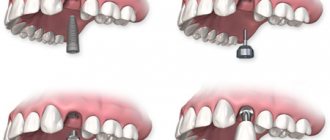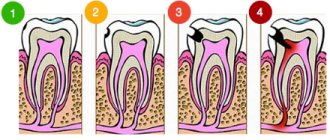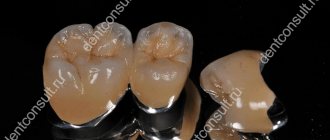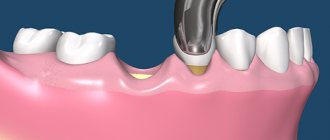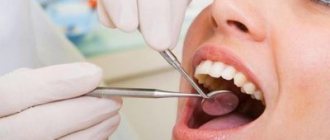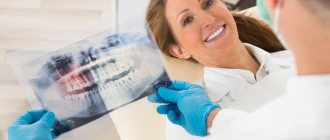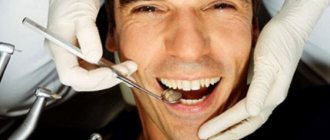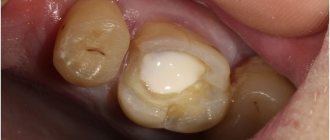Many orthodontists consider childhood to be the most appropriate age for correcting the position of teeth that have erupted and are just beginning to emerge, and for correcting malocclusion. This is due to the fact that the child’s jaw is still developing, so in a short time it is possible to correct existing defects and prevent the situation from getting worse. The most common reason for a child’s malocclusion is the lack of attention to this problem on the part of his mother. It is normal for a child to have a lower jaw that is smaller than the upper jaw, but during natural feeding this defect is usually corrected.
Many orthodontists consider childhood to be the most appropriate age for correcting the position of teeth that have erupted and are just beginning to emerge, and for correcting malocclusion.
The main causes of malocclusion:
- The hole in the nipple is too large (with artificial feeding). The child does not need to make any effort to obtain food and the jaw does not work or develop.
- Lack of roughage in the diet;
- Lack of minerals and vitamins in the body;
- Mouth breathing due to problems with blocked sinuses.
However, all this is not an insurmountable obstacle to getting a child a beautiful smile with straight teeth.
The most common reason for a child’s malocclusion is lack of attention from his mother.
Orthodontic equipment for teeth straightening and bite formation
There are several tools to straighten your teeth and form your bite:
- Trainers;
- Braces;
- Plates for teeth straightening.
Trainers
Most orthodontic devices designed to correct malocclusion eliminate the consequences of the pathological process, without excluding its cause. A dental trainer is a device that performs both tasks. Wearing trainers helps develop the jaw muscles, reduce pressure on the jaw bones, restore breathing through the nose and correct tongue position. Suitable for treating children from 5 years of age. They are especially effective when replacing baby teeth with permanent ones to correct their incorrect position. Wearing time is limited to night and a few hours during the day.
An impression is not required for production. Transparent silicone is used in different colors to make them more interesting for children to wear. Adapts well and does not affect diction. It is used for minor bite deviations, and can even replace braces if there are contraindications to wearing them.
First, trainers with soft silicone are used. Later, more stringent ones are used. Used for: deviations in tooth growth (location, direction, etc.), impaired swallowing function, pathologies of the oral cavity leading to chronic nasal congestion. They require daily care just like all devices.
Braces
Braces are special linings for each tooth, which are strung on a rigid metal arch. The main qualities of the arc:
- Strength;
- Elasticity;
- Availability of shape memory. No matter how the wire is bent during the treatment process, it tends to take its original shape.
Braces are the most common way to correct malocclusions. Starting from the age of 12 (the average period for the final eruption of permanent teeth), they can be installed in children. Braces are a non-removable device. They are attached to each tooth. Wearing them requires regular visits to your doctor, who determines and regulates the tension of the wire. When wearing braces, they are quite noticeable, and this affects the teenager’s behavior (they become more shy, tense and smile less often). The use of braces requires increased attention to oral hygiene (food gets stuck in the system) and imposes restrictions on the consumption of certain foods (hard and viscous). But despite the disadvantages, this is a very strong and durable design that allows you to eliminate many bite defects.
The use of braces requires increased attention to oral hygiene
Retainer
A retainer (in this case, a permanent retainer) is a thin wire made of the same material as the bracket arch. It is not an independent orthodontic device, but serves to prevent aligned teeth from returning to their original place. It is usually installed before removing braces, so we decided to mention it. It is not noticeable to others because it is attached to the inside of the jaw, where it is secured with dental cement that hardens under the influence of ultraviolet radiation. It is almost impossible to tear off, so there are no restrictions on eating hard and sticky foods.
Correct your bite or dental defect with invisible aligners Find out what it is
Correction of mesial bite
People with this defect tend to have a protruding chin. If the flaw is inherent in a man, then the aesthetics may not be disturbed, since the face takes on a strong-willed and decisive expression. When a girl is susceptible to the defect, bite correction is required immediately. The consequences are as varied as with distal closure of teeth. This is the risk of early onset of periodontal diseases, the development of caries, and the complexity of prosthetics.
Mesial correction of occlusion in adults is a lengthy process. The sooner orthodontic treatment is carried out, the sooner the result is achieved. The ideal time for this is considered to be childhood, when the development of the jaw apparatus is not yet complete. In this case, different removable structures are used. In adults, dental braces, possible removal of some row elements, and orthognathic operations are most often used.
Plates for teeth straightening
Orthodontic plates are often called “braces” or “plates on the teeth.” This device is used to treat children under 15 years of age. Made individually for each child. It is attached to the outer surface, the inner part and can partially cover the sky. Made from soft or medium hard plastic and metal. The child takes food without any discomfort. There is no need for any special care for the plates.
Purpose:
- abnormal development of the bones of the jaw arches (narrowness of the jaw bone or disruption of its shape);
- the need to adjust the position of one or more teeth;
- movement of individual teeth;
- the presence of gaps between teeth (three and diastemas);
- the need to correct the narrowing of the palate;
- activation or slowdown of the jaw growth process;
- consolidation of results after using other orthodontic systems;
- preventing crowding;
- prevention of relapses of malocclusion, etc.
There is no need for any special care of the plates
What problems do plates help with?
Plates are the simplest orthodontic instrument. Accordingly, they are used to solve minor defects in bite or position of teeth in the dentition. The standard case when a patient is prescribed to wear such a device is incorrect placement of the incisors. In this case, the structure is made in such a way that the main pressure falls on the desired tooth.
Another defect, which is a prerequisite for using this method, is abnormal expansion or narrowing of the jaw. In this case, the patient may experience the appearance of a gap between the teeth. In this case, the structure is adjusted so as to put pressure on the entire plane of the dentition.
A dental plate is also prescribed in other cases when slight curvatures of an individual tooth or dentition have been noticed in a child or adult.
Classification of plates for teeth straightening
According to use, the equipment is:
- removable;
- non-removable.
Removable
– the simplest design, and is installed on children from 7 to 15 years old for short-term correction of teeth or bite. Fixed with hooks and worn daily. The duration of wearing is determined by the attending physician. They are most often made of plastic, but sometimes they come in complex designs that include springs and screws. The doctor periodically adjusts the device to obtain gentle pressure on the teeth. This achieves a positive therapeutic effect. The teeth are straightened and the bite is corrected. Such equipment is used when it is not possible to correct the defect using only a plate. Can be installed on both the upper and lower jaw.
Fixed (stationary)
– installed once using fixing brackets that prevent movement when eating, for up to two years. Monitoring and adjustment is carried out by the attending physician during a scheduled visit. It is most often used for young children and to correct serious developmental defects of the jaw apparatus.
Differences:
- stationary is more effective in correcting defects. More expensive than the removable version;
- removable, easy to remove at any time. Easier to care for.
According to the material of manufacture:
- metal;
- plastic.
Metal
– made of titanium-nickel or titanium-molybdenum alloy, which do not oxidize in the aggressive environment of the oral cavity. Outwardly it looks like a combination of wires and hooks. It can be either removable or non-removable. Used to treat children of all ages.
Plastic
– most of these plates are removable and are intended for treating children of middle and older age groups.
By purpose and device:
- Single-jaw – used to restore the dentition when it is shortened or narrowed, as well as to eliminate defects of individual teeth. Consist of a plate with adjustable orthopedic screws. Suitable for children of all ages.
- With retraction arch. Correct protrusion of teeth in a row. Based on the elastic properties of the arc. Suitable for correction on both jaws.
- With a hand-shaped process on an arch. Correct the position of individual teeth. The process puts pressure on the tooth and aligns its position. Can be installed on both the upper and lower jaw.
- With active pusher. Used to straighten the maxillary anterior incisors. The dentition is aligned with spring mechanisms for each uneven tooth.
- The Andresen-Goipl apparatus (activator) is a removable orthodontic device of combined action designed to correct occlusal defects. The activator makes it possible to fix the lower jaw in the required (extended) position, which gives impetus to its development. In this regard, the growth of the upper jaw is inhibited, the bite is disconnected, and the work of the facial and masticatory muscles returns to normal. Placing the inclined plane of the plate along the entire dentition makes it possible to move teeth in three planes - to the side, back and forward. This allows, with some design changes and additions to the activator, to successfully use it to correct not only distal occlusion, but also other deviations of occlusion.
- Bruckle's appliance is a removable device designed to correct deep mesial bite. It is installed only on the lower jaw, and, due to its design features, it has a positive effect on both dentitions.
- Frenkel apparatus - lip pads, brush shields, and other additional elements are installed on a metal frame. The device is attached simultaneously to both jaws and has a functionally targeted action that limits unnecessary muscle force. The use of the device promotes the normal development of the jaws, dental arches and rows. Open, distal and mesial bites are corrected, but the complexity and duration of production, as well as the high cost, do not contribute to its popularity.
The procedure for adjusting and installing the plate is simple and painless. At first, the child feels discomfort from the presence of the equipment in the mouth, but then he gets used to it.
Correction of distal bite
A characteristic feature of the distal bite is the protruding front teeth of the upper row. Dentists recommend correcting the bite in dentistry when the upper jaw seems overdeveloped compared to the lower jaw. In this case, a person’s chewing load on the teeth is disrupted, as a result of which the posterior lateral sections become susceptible to an increased risk of developing caries, and soft tissues to the development of periodontal disease. From the outside, it appears that the patient's face has a small chin. Thus, orthodontists achieve an even distribution of proportions to all parts of the face. To select defect correction designs, dentists take into account the patient’s age. In early childhood, bite correction methods are used to restrain the growth of the upper jaw and stimulate the development of the lower jaw. In adults, preference is most often given to braces.
Procedure for making and installing plates for teeth straightening
The selection and production of plates for correcting the bite is carried out only after examination by an orthodontist. The technique is as follows:
- A volumetric image of the jaw bone tissue (OPTG) is taken;
- Impressions of the jaws are taken;
- They are sent to a dental laboratory to produce the selected plate;
After the orthodontic equipment has been manufactured, the doctor installs it and explains to the parents and child how to wear it. The fixed structure takes a little longer to install than the removable one. The procedure for adjusting and installing the plate is simple and painless. At first, the child feels discomfort from the presence of the equipment in the mouth, but then he gets used to it.
What is the price of a dental plate?
A plate for straightening teeth is the most inexpensive way to correct a bite. With this method of treatment, the doctor does not have to stick a bracket on each tooth, which takes quite a lot of time and money. Adjusting the plate also takes much less time than adjusting each bracket individually.
Quite often, thanks to just one plate, the bite can be completely corrected. If the problem was too serious, there is a chance that the patient will still have to wear braces during adolescence. However, the duration of wearing them will be significantly less than if the child did without the plate in childhood - which means the cost of orthodontic services will also be lower.
ATTENTION:
After wearing fixed braces during adolescence, wearing a plate may be necessary to consolidate the effect. This will not depend on whether the child wore the record as a child.
Indications and contraindications for installing braces
The appointment and selection of the correct design is recommended by the doctor.
Treatment is prescribed in the following cases:
- Incorrect position of one or more teeth;
- Jaw bone development problem;
- Narrowing of the palate;
- Malocclusion;
- Teeth displacement after braces;
- Rare arrangement of teeth.
Orthodontists recommend installing plates for children under 12 years of age.
Often plates are placed on braces after treatment to secure the result as a retainer. You shouldn't be afraid of this.
In this age:
- the body grows and corrections occur quickly;
- children at this age are not so painfully worried about the installation of plates;
- children are more obedient and will not remove the plates often.
Plates are not installed in the following cases:
- untreated caries;
- gum disease;
- allergy to plate material;
- respiratory tract diseases;
- presence of stomatitis that requires treatment;
- abnormalities have been identified that require other treatment methods.
Correction of deep bite
Ideally, the top row protrudes slightly forward and covers the bottom row by 1/3. When the teeth cover the underlying elements by more than half, we are talking about a deep form of malocclusion. Correction of dental occlusion is required due to an aesthetic defect in which the face is not elongated enough along the vertical axis, and the lower lip protrudes. The owner of such a defect also faces functional problems, due to which periodontal diseases develop, teeth become loose, gums become inflamed, mechanical damage to soft tissues often occurs with teeth, and enamel quickly wears off.
If teeth are not corrected on time, the functioning of the jaw joint is disrupted, and a crunching sound appears when the jaw moves. Clicking sounds may be heard and symptoms of pain may occur. When dental prosthetics is performed, this pathology is also subject to correction. Dentists use treatment based on a number of structures that increase the level. The device can be a brace system, special plates and other products.
How long should you wear braces?
At the time of active formation of the dentition, the plates are changed approximately every six months. The duration of treatment is determined individually. Usually the defect is corrected in a year to a year and a half, further time is required to consolidate the result. Often plates are placed on braces after treatment to secure the result as a retainer. You shouldn't be afraid of this.
Caring for teeth straightening plates
In order for the equipment to work as expected, you need to perform simple operations. For this it is recommended:
- Clean the plate with a soft toothbrush;
- Use special cleaning gels (daily and weekly);
- Do not engage in active sports with the plate on;
- Store the equipment in a special container;
- Do not try to repair the plate yourself if you discover damage or deformation. You should consult your doctor;
- Treat the structure with a disinfectant solution. If the plate is removable, it is better to place it in the solution overnight;
- Remove the removable plates when eating;
- Before installation, rinse with warm boiled water;
- If the equipment design has a screw, it is recommended to lubricate it with vegetable oil so that it does not stagnate;
- Parents should ensure that the child does not remove the equipment at night;
- Teach your child how to tighten a screw in a plate;
- To avoid complications, periodically visit an orthodontist and follow his instructions;
- Carefully monitor oral hygiene during treatment (the presence of plates increases plaque in the mouth);
- If plaque or tartar is found on the plate, you should consult a doctor for cleaning.
The treatment is helped by a special massage that affects the gums and palate. By improving blood circulation, massage accelerates the healing and growth processes in the jaw area. This massage is performed while brushing your teeth.
How to care for the plate
The removable product must be removed before eating, playing sports or intense physical activity. The product should not be removed while sleeping, as this will delay the treatment process. As for whether it is necessary to remove the device while eating, there is no clear answer: the doctor will have to make an individual recommendation. It should be taken into account that most plates can be stained by food.
The record must be stored in a special sealed container, which will be provided by the orthodontist. Wrapping the device in a cloth or paper napkin is strictly prohibited: practice shows that you are likely to break it or accidentally throw it away.
Clean the plate twice a day, after waking up and before going to bed. To do this, it will be enough to use a regular toothbrush and toothpaste. Many brands produce specialized liquid and tablets for the care of such devices.
ATTENTION:
When cleaning, you need to pay special attention to the places where the screws are located. This is where food debris most often accumulates and creates a favorable environment for the proliferation of pathogenic microorganisms.
During the day, you should rinse your mouth as often as possible to eliminate bacterial plaque that contributes to the development of caries. You should brush your teeth in the morning and evening while wearing the plate especially long and thoroughly. If tartar is found on the device, you should inform your treating specialist, and he will give advice on how to remove it.
What is better - braces or braces?
The plates are only effective for people under 15 years of age and may not help in some situations. And even at the age of 10-12 years, in some cases it is necessary to install braces. If the pathologies are minor and are in the initial stage, then it is enough to use plates.
Advantages:
- Possibility to remove if necessary;
- Easy to care for your oral cavity;
- Cheaper than braces.
Flaws:
- Often not effective enough;
- Long-term addiction.
Advantages of braces:
- Continuous action on teeth;
- Quick addiction;
- A larger number of defects can be eliminated simultaneously.
Flaws:
- Difficulties in caring for the oral cavity;
- High cost for the entire range of services.
Reviews of plates for teeth straightening
Looking through the reviews from parents, it can be noted that they are all positive. Children quickly get used to wearing the equipment. All dental defects are corrected quickly. It cannot be said that for all children the operation with the installation of plates is completely painless, but if everything is chosen correctly, the inconvenience quickly passes.
Dentists also respond well to the plates. Some believe that in adults, correcting defects with plates is even more convenient. For them, this is done even longer, once, but in children, as the jaw grows, the correction plates need to be changed.
Crossbite correction
The pathology manifests itself in the weak development of one side of the jaw. Surgical correction may be required, although in some cases the defect can be treated with removable and permanent repairs. It is observed on one or both sides of the jaw, on any zone of the row - front or side. Leads to severe impairment of chewing functionality. Frequent companions of the defect are early periodontal disease, caries, crunching and pain when opening the jaws. You can apply for correction yourself. The dentist who provides dental treatment or selects the type of prosthetics to restore the integrity of the rows may also recommend undergoing the procedure for correcting the defect.
Summing up
Children's teeth are not only a cheerful smile. It is also an important link in the digestive tract. Depending on the quality of chewing food, the further process of digestion also depends. Disease of the teeth and gums often leads to inflammation of other organs. It is necessary to monitor the condition of a child’s teeth from a very early age. Replacing baby teeth with permanent ones should be natural. Often, an extracted baby tooth causes the molar to erupt in the wrong place, and as a result, the need for orthodontic treatment with plates or braces. Doctors say: “It is better to prevent a disease than to treat it.”
The appearance of malocclusion or crooked teeth must be corrected as early as possible. To identify abnormalities in a timely manner, it is recommended to bring your child for examination to the dentist at least twice a year, starting from the age of one.
Parents should ensure that their child learns to brush his teeth well as early as possible and help him do it correctly.
Periodically examine his oral cavity and if you notice a brown or white spot on his teeth, immediately contact a dentist. Currently, doctors have completely painless ways to treat caries.
When the plate is activated
Parents should not worry about how to tighten the structure. The doctor will show you how to do this at the first and subsequent appointments.
The initial activation is not performed immediately after fixation of the device, but after 1-2 weeks, so that the small patient gets used to his new condition and the constant presence of arches in the mouth.
How often teeth plates are tightened depends on the individual schedule. After the initial activation, you need to do this quite rarely, approximately every 3 weeks (sometimes at intervals of a month), so that the load on children's jaws increases gradually. Then the arches are adjusted much more often (every 7-15 days). When therapy is nearing completion, manipulations are carried out every 3-5 days.
The device is activated by unwinding the drum located in the orthodontic screw placed on the plate. You must use a special key for this. It is issued at an appointment with the orthodontist.
